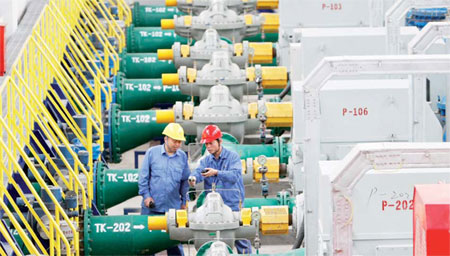Water from the sea
Updated: 2012-03-09 08:36
By Hu Haiyan (China Daily)
|
|||||||||||
|
China plans to increase its seawater desalination capacity to 2.6 million cubic meters a day by 2015. Hu Qingming / for China Daily |
Growing scarcity, govt support provide new impetus to desalination industry
Even in his 80s, Samuel Muller has not lost interest in talking about the huge potential of China's water desalination market.
The vice-president of Brack Capital Infrastructure Development (BCID), an Israeli seawater desalination company, says the Chinese government's announcement in February planning for a fourfold increase in daily seawater desalination capacity will make the nation one of the most exciting markets in the world.
Desalination capacity is set to increase from 660,000 cubic meters in 2011 to 2.6 million cubic meters by the end of 2015.
"This marks a milestone for the desalination market in China and its subsequent development. Policy stimulants are always important," says Muller, who has worked in the desalination industry since the 1970s.
His company is investing heavily in China and is setting up desalination plants in Tangshan, Hebei province, and Tianjin to grab a slice of the huge pie.
You Jinde, general secretary of the Membrane Industry Association of China, says the undervalued desalination industry has got a new impetus following the government move to establish a national desalination industry.
"Even though China started desalination work in the 1960s it was never given the importance accorded to other water projects like the government-financed South-to-North Water Diversion Project, which brings water from the Yangtze River in the south to the north. Desalination needs government support, as the cost price of desalinated water far exceeds the selling price," You says.
Due to the stimulus policies implemented during the 11th Five-Year Plan (2005-10), China's desalination capability has made a big stride, with capacity going up to 660,000 cubic meters compared with 50,000 cubic meters a day in 2005.
But it is still far from enough. According to the announcement made by the National Development and Reform Commission, China's freshwater resources per capita are just 2,100 cubic meters, about 28 percent of the global average. And nearly two-thirds of Chinese cities are facing a shortage of water.
It also states that in the next five years, China will build up a chain of seawater desalination facilities and technologies. Chinese companies are expected to develop nearly 70 percent of the desalination equipment required for these projects. Such moves will automatically enhance the capabilities and strengths of domestic companies, experts say.
Zheng Genjiang, the director of the Hangzhou Development Center of Water Treatment Technology, says that the speed at which China is raising its capability to desalinate seawater and develop its own desalinating equipment or patent desalination technologies, demonstrates its determination to ensure sustainable supplies of fresh water and to protect water resources.
"Some key and sophisticated desalination technologies and equipment like reverse osmosis membranes are completely controlled by foreign companies.
Of the more than 660,000 cubic meters of desalinated water produced daily, only 80,000 cu m comes from the plants that are fully constructed by Chinese companies.
Though the government is looking to enhance the capabilities of domestic companies, it has not been a deterrent to foreign firms.
Fu Kangbo, general manager of Hydranautics China, a subsidiary of Nitto Denko from Japan, says that the bigger size of the pie will more than offset the increased competition from domestic players.
"Honestly speaking, it is hard for the Chinese companies to realize the goal of developing over 70 percent of the desalination equipment without any help from their foreign counterparts. Cooperation is the only way forward for the industry," he says.
Fu says his company will maintain its 40 percent share of the Chinese desalination membrane market even in 2015. "We also expect a fourfold increase in our annual sales by then," he says.
It is expected that by 2015 China may invest about 30 billion yuan ($4.8 billion, 3.6 billion euros) in the desalination sector.
The pie is expanding, but some players in this market are not so optimistic in their assessment.
Fan Xiong, chief engineer of China Metallurgical Group Seawater Desalination Investment Co Ltd, says the desalination sector in China is not that profitable, as water tariffs and the demand for desalinated water are low.
"In nations like Israel desalinated water is treated as a commodity, but in China it is considered a public utility and as such the prices cannot reflect the investment and operation costs. On an average it costs 8 yuan to make a ton of desalinated water in China. But the selling price is 4 yuan a ton," Fan says.
"Now we are also searching for some overseas investment opportunities," he says.
What seems to back Fan's view is that none of the companies interviewed could reveal margins from the desalination business in China.
"Just like a baby starting to grow up, it is not so meaningful to take the current weight into consideration when predicting how much weight he will gain in the future. As long as he is healthy and has got enough favorable conditions to develop, it is enough," says Guo Huiping, vice-president of China Electronics Engineering Design Institute, affiliated to the State Development & Investment Corp.
huhaiyan@chinadaily.com.cn
(China Daily 03/09/2012 page5)
Today's Top News
Rescuers race against time for quake victims
Telecom workers restore links
Coal mine blast kills 18 in Jilin
Intl scholarship puts China on the map
More bird flu patients discharged
Gold loses sheen, but still a safe bet
US 'turns blind eye to human rights'
Telecom workers restore links
Hot Topics
Lunar probe , China growth forecasts, Emission rules get tougher, China seen through 'colored lens', International board,
Editor's Picks

|

|

|

|

|

|






